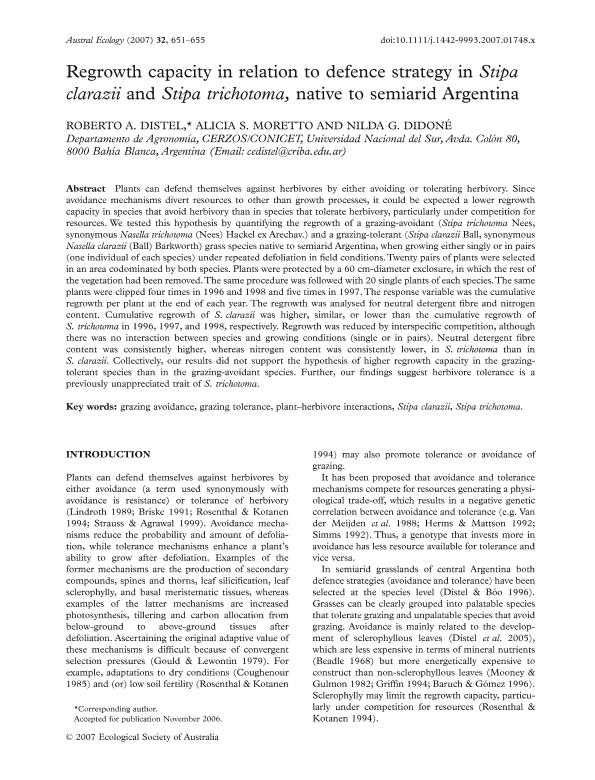Mostrar el registro sencillo del ítem
dc.contributor.author
Distel, Roberto Alejandro

dc.contributor.author
Moretto, Alicia Susana

dc.contributor.author
Didone, Nilda Graciela

dc.date.available
2018-01-29T14:18:37Z
dc.date.issued
2007-09
dc.identifier.citation
Distel, Roberto Alejandro; Moretto, Alicia Susana; Didone, Nilda Graciela; Regrowth capacity in relation to defence strategy in Stipa clarazii and Stipa trichotoma, native to semiarid Argentina; Wiley; Austral Ecology; 32; 6; 9-2007; 651-655
dc.identifier.issn
1442-9985
dc.identifier.uri
http://hdl.handle.net/11336/34832
dc.description.abstract
Plants can defend themselves against herbivores by either avoiding or tolerating herbivory. Since avoidance mechanisms divert resources to other than growth processes, it could be expected a lower regrowth capacity in species that avoid herbivory than in species that tolerate herbivory, particularly under competition for resources. We tested this hypothesis by quantifying the regrowth of a grazing-avoidant (Stipa trichotoma Nees, synonymous Nasella trichotoma (Nees) Hackel ex Arechav.) and a grazing-tolerant (Stipa clarazii Ball, synonymous Nasella clarazii (Ball) Barkworth) grass species native to semiarid Argentina, when growing either singly or in pairs (one individual of each species) under repeated defoliation in field conditions. Twenty pairs of plants were selected in an area codominated by both species. Plants were protected by a 60 cm-diameter exclosure, in which the rest of the vegetation had been removed. The same procedure was followed with 20 single plants of each species. The same plants were clipped four times in 1996 and 1998 and five times in 1997. The response variable was the cumulative regrowth per plant at the end of each year. The regrowth was analysed for neutral detergent fibre and nitrogen content. Cumulative regrowth of S. clarazii was higher, similar, or lower than the cumulative regrowth of S. trichotoma in 1996, 1997, and 1998, respectively. Regrowth was reduced by interspecific competition, although there was no interaction between species and growing conditions (single or in pairs). Neutral detergent fibre content was consistently higher, whereas nitrogen content was consistently lower, in S. trichotoma than in S. clarazii. Collectively, our results did not support the hypothesis of higher regrowth capacity in the grazing-tolerant species than in the grazing-avoidant species. Further, our findings suggest herbivore tolerance is a previously unappreciated trait of S. trichotoma.
dc.format
application/pdf
dc.language.iso
eng
dc.publisher
Wiley

dc.rights
info:eu-repo/semantics/openAccess
dc.rights.uri
https://creativecommons.org/licenses/by-nc-sa/2.5/ar/
dc.subject
Plant-Herbivore Interactions
dc.subject
Grazing Tolerance
dc.subject
Grazing Avoidance
dc.subject
Interactions
dc.subject
Stipa Clarazii
dc.subject
Stipa Trichotoma
dc.subject.classification
Otras Ciencias Agrícolas

dc.subject.classification
Otras Ciencias Agrícolas

dc.subject.classification
CIENCIAS AGRÍCOLAS

dc.title
Regrowth capacity in relation to defence strategy in Stipa clarazii and Stipa trichotoma, native to semiarid Argentina
dc.type
info:eu-repo/semantics/article
dc.type
info:ar-repo/semantics/artículo
dc.type
info:eu-repo/semantics/publishedVersion
dc.date.updated
2017-10-26T14:41:00Z
dc.journal.volume
32
dc.journal.number
6
dc.journal.pagination
651-655
dc.journal.pais
Estados Unidos

dc.journal.ciudad
Hoboken
dc.description.fil
Fil: Distel, Roberto Alejandro. Consejo Nacional de Investigaciones Científicas y Técnicas. Centro Científico Tecnológico Conicet - Bahía Blanca. Centro de Recursos Naturales Renovables de la Zona Semiárida. Universidad Nacional del Sur. Centro de Recursos Naturales Renovables de la Zona Semiárida; Argentina
dc.description.fil
Fil: Moretto, Alicia Susana. Consejo Nacional de Investigaciones Científicas y Técnicas. Centro Científico Tecnológico Conicet - Bahía Blanca. Centro de Recursos Naturales Renovables de la Zona Semiárida. Universidad Nacional del Sur. Centro de Recursos Naturales Renovables de la Zona Semiárida; Argentina
dc.description.fil
Fil: Didone, Nilda Graciela. Consejo Nacional de Investigaciones Científicas y Técnicas. Centro Científico Tecnológico Conicet - Bahía Blanca. Centro de Recursos Naturales Renovables de la Zona Semiárida. Universidad Nacional del Sur. Centro de Recursos Naturales Renovables de la Zona Semiárida; Argentina
dc.journal.title
Austral Ecology

dc.relation.alternativeid
info:eu-repo/semantics/altIdentifier/url/http://onlinelibrary.wiley.com/doi/10.1111/j.1442-9993.2007.01748.x
dc.relation.alternativeid
info:eu-repo/semantics/altIdentifier/doi/http://dx.doi.org/10.1111/j.1442-9993.2007.01748.x
Archivos asociados
